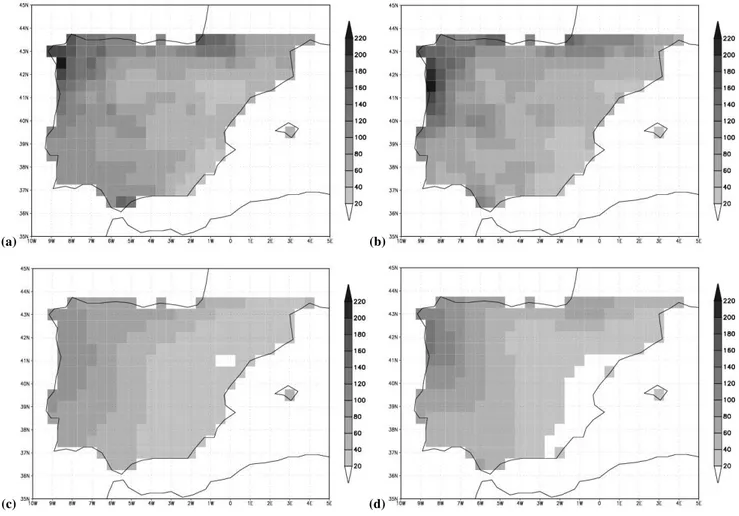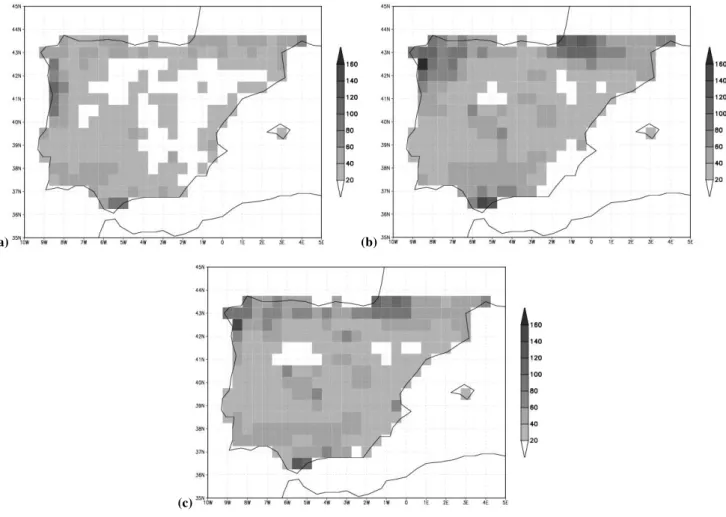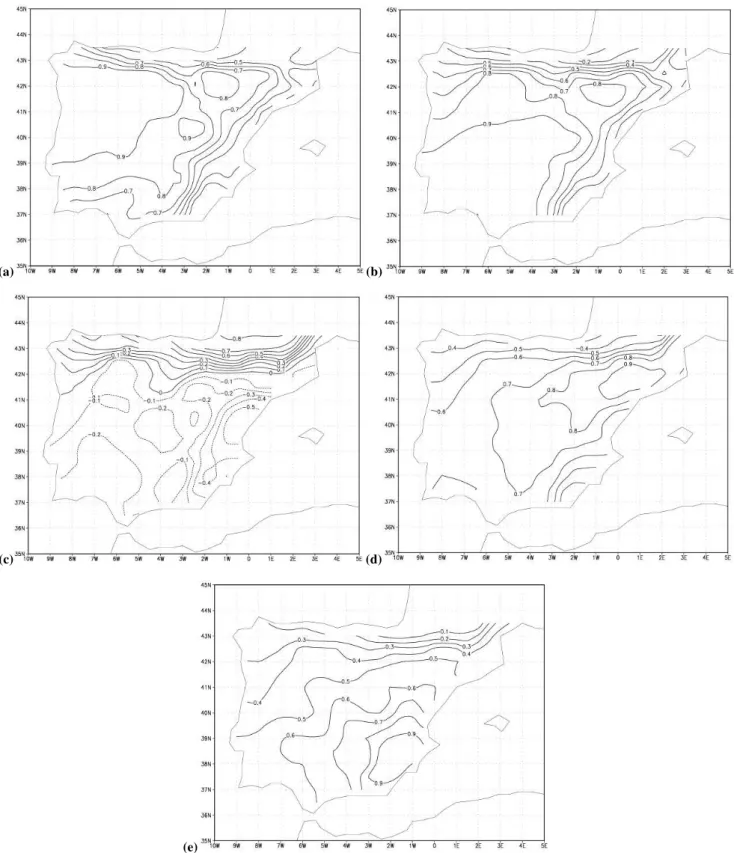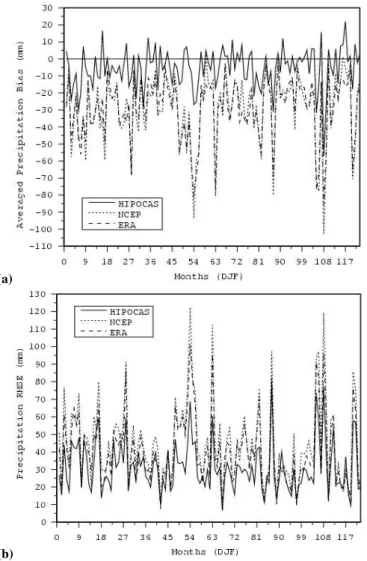M. G. Sotillo1, M. L. Mart´ın2, F. Valero3, and M. Y. Luna4
1Area de Medio F´ısico, Ente P´ublico Puertos del Estado (EPPE), Madrid, Spain´ 2Escuela de Inform´atica, Campus de Segovia, Universidad de Valladolid, Spain 3Facultad de CC. F´ısicas, Universidad Complutense de Madrid, Spain
4Instituto Nacional de Meteorolog´ıa, Madrid, Spain
Received: 7 October 2005 – Revised: 1 December 2005 – Accepted: 19 December 2005 – Published: 19 April 2006
Abstract. Generation of a Mediterranean long-term (1958– 2001) homogeneous high resolution environmental database constituted the main objective whitin the HIPOCAS Project. The high number of parameters included in this database al-lows a complete characterization of Mediterranean storms. In this paper, the HIPOCAS precipitation reliability over the Iberian Peninsula and the Balearic Islands is evaluated against long-term in-situ observations from Iberia. In or-der to provide a more complete study, comparisons of the HIPOCAS field with NCEP/NCAR and ERA global reanal-ysis show the important improvement in the characterisation of the observed precipitation introduced by the HIPOCAS hindcast.
1 Introduction
In general terms, the major methodological drawback for a long-term assessment of regional climate and its variability comes from the lack of suitable observation or simulated data. It is well known that the coarse spatial resolution of global reanalysis make these data sets a not completely ad-equate tool to characterize regional prevailing atmospheric conditions over areas marked by complex orography and land-sea distributions such as the Mediterranean Basin. In that sense, the generation within the HIPOCAS Project framework of a Mediterranean long-term (1958–2001) ho-mogeneous high resolution atmospheric database comes to overcome the above-referred shortcomings providing a use-ful data set for regional studies. The present contribution is concerning to the HIPOCAS precipitation over the Iberian
Correspondence to:M. G. Sotillo (marcos@puertos.es)
Peninsula and the Balearic Islands, evaluating its reliability against long-term in-situ observations from Iberia. Further-more, the HIPOCAS significant improvement in comparison to NCEP/NCAR and ERA global reanalysis is evaluated.
2 Data and methodology
The HIPOCAS long-term database is the result of an atmo-spheric hindcast performed over the whole Mediterranean Basin. In order to produce the 44-year (1958–2001) hind-cast the regional atmospheric model REMO was used. The whole Mediterranean basin was covered by a grid with horizontal resolution of 0.5◦×0.5◦ (roughly 50×50 km2). NCEP/NCAR global reanalysis (Kalnay et al., 1996) were used as initial and boundary conditions. An spectral nudg-ing technique was applied to keep the regional run close to the imposed time-variable large-scale atmospheric states provided by the NCEP forcing. Further information on the HIPOCAS Mediterranean data base and its generation can be found in Sotillo et al. (2005).
(a) (b)
(c) (d)
Fig. 1.Winter spatial distributions of monthly mean precipitation fields (mm) of:(a)IPD;(b)HIPOCAS;(c)NCEP and(d)ERA.
original resolution (around 200 km and 125 km, respectively) to the HIPOCAS grid and were used in order to complete the HIPOCAS validation.
In order to validate the HIPOCAS winter precipitation dataset several products were derived. A general descrip-tion of HIPOCAS, NCEP, ERA and IPD datasets was made by means of statistics such as precipitation means and root mean squared error (RMSE). The temporal evolution of the spatial average bias and RMSE were derived to evaluate the different model performance ability. Likewise, a principal component analysis (PCA) with a varimax orthogonal rota-tion procedure was applied to the databases in order to eval-uate the different model performance ability in reproducing the observed spatial precipitation patterns, as well as their temporal evolution.
3 Results
This validation was performed through comparisons with the observed IPD set taking into account the described method-ology. The 41-winter monthly mean IPD precipitation field (Fig. 1a) shows the well-known differences in precipitation
behaviour between the Atlantic and Mediterranean areas of the Iberian Peninsula. The analogous HIPOCAS precipita-tion field (Fig. 1b) shows well agreement, not only in the spatial gradient but also in the absolute precipitation val-ues. Similar comparison was performed using the NCEP and ERA global reanalysis data sets (Figs. 1c and d), show-ing similar spatial distributions with the maximum clearly lower than the observed IPD and hindcasted HIPOCAS. The RMSE spatial distributions (Figs. 2b and c) show slight en-hancement of ERA versus NCEP which is largely improved by the HIPOCAS performance (Fig. 2a).
(a) (b)
(c)
Fig. 2.Root mean squared error (mm) between(a)IPD and HIPOCAS fields;(b)IPD and NCEP fields and(c)IPD and ERA fields.
precipitation fields (Fig. 4) highlights strong agreement be-tween both fields showing a clear E-W gradient with an increased westward correlation. Whereas the highest val-ues (higher than 0.80) are located over the western side of the Iberian Peninsula, the lowest ones are located along the Mediterranean coast, specially in its southeastern part. This area shows low winter precipitation records (as can be seen in Fig. 1a), and it is characterized by a seasonal maximum in autumn, being this maximum linked to strong convective storm activity related to the typical intense Mediterranean ci-clogenesis (Valero et al., 2004). It is also worth to mention that other HIPOCAS validation works focused on variables such as the 10-m wind field, waves and sea level data, have also identified the southeastern Iberia as an area where the HIPOCAS hindcast does not present its better performance (Sotillo et al., 2005).
In order to provide a more complete view of the NCEP, ERA and HIPOCAS performances that allow the observed Iberian precipitation field along the 41-year period to be characterised, Fig. 4 also displays the time evolution of the bias (Fig. 5a) and the RMSE (Fig. 5b) averaged over the whole spatial domain. Both figures highlight the much bet-ter HIPOCAS performance for reproducing the observed IPD field, in comparison with the global reanalysis data.
4 Conclusions
(a) (b)
(c) (d)
(e)
Fig. 4. Temporal correlation between IPD and HIPOCAS precipi-tation fields.
(a)
(b)
Fig. 5. Temporal evolution of: (a)the bias and(b)the root mean squared error averaged over the whole spatial domain for the used datasets.
References
Gibson, J. K., Kallberg, P., Uppala, S., Hern´andez, A., ˜Nomura, A., and Serrano, E. : ERA description. Technical Report Re-analysis Project Report Series 1, ECMWF, Reading, UK, 1997.
Kalnay, E., and co-authors: The NCEP/NCAR 40-years Reanalysis, Project. Bull. Amer. Meteorol. Soc., 77, 437–471, 1996. Luna, M. Y. and Almarza, C.: Interpolation of 1961–2002 daily
climatic data in Spain, Proc. International Meeting on Spatial In-terpolation in Climatology and Meteorology, Budapest, Hungry, 2004.
Sotillo, M. G., Ratsimandresy, A. W., Carretero, J. C., Bentamy, A., Valero, F., Gonz´alez-Rouco, J. F.: A high-resolution 44-year atmospheric hindcast for the Mediterranean Basin: Contribution to the regional improvement of global reanalysis, Clim. Dyn., 25, 219–236, 2005.



